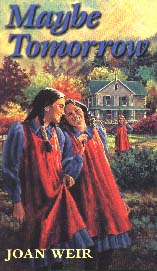|
________________
CM . . . .
Volume VII Number 15 . . . . March 30, 2001
excerpt: The cold knot of fear in Jane's stomach grew tighter. If Charys was right and the other Board Members knew nothing about the students except what they were told, then sooner or later Belinda's mother would get her way.The girls attending All-Hallows School have come for very different reasons. Jane, a preacher's daughter, has been sent to school by her mother to try and dissuade her from marrying and becoming a homesteader; Sesuq's grandmother believed that Sesuq will find out if she was meant to become a storyteller by attending school; Charys' father wanted to keep her away from her sickly brother; and Belinda came there as a second choice--the all-White Angela College for Girls in Victoria was full. The story centers around Jane's and Sesuq's developing friendship which faces challenges from the one-note character of Belinda, whose principal job is to carp against Natives attending the school, using her washbasin, or spending time with any of the White girls. The four girls all achieve the ends they were hoping for: Jane will marry; Charys goes home; Sesuq, after having been expelled, will become a storyteller; and Belinda is named the student of the year. The girls will each be set on the path they desired, all ending happily ever after, without dealing with Sesuq's unfair expulsion from the school, something which might bother younger readers. There is an epilogue to the story that says that the lesson of the school, that Natives are intelligent and could co-exist, compete and flourish on an even ground with Whites, has been forgotten. Unfortunately, the characters are too flat to carry much weight. Belinda is never given an opportunity to learn from her mistakes, and the other characters, Sesuq, Charys, and Jane, are too good to make any mistakes. The characters, usually representing one point of view, don't present a historical viewpoint so much as a pastiche of earlier cardboard melodramas. Recommended with Reservations. Betsy Fraser is a librarian with Calgary Public Library.
To comment on this title or this review, send mail to cm@umanitoba.ca.
Copyright © the Manitoba Library Association.
Reproduction for personal use is permitted only if this copyright notice
is maintained. Any other reproduction is prohibited without
permission.
Published by
TABLE OF CONTENTS FOR THIS ISSUE - March 30, 2001.
AUTHORS |
TITLES |
MEDIA REVIEWS |
PROFILES |
BACK ISSUES |
SEARCH |
ORDER |
CMARCHIVE |
HOME
|
